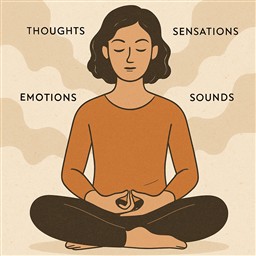
Choiceless Awareness meditation is a form of mindfulness where the practitioner observes whatever arises in the present moment—thoughts, sensations, emotions, sounds—without judgment, preference, or control. The term was popularized by Jiddu Krishnamurti, a 20th-century philosopher and spiritual teacher.
Key Features of Choiceless Awareness:
-
Non-selective Attention
You don’t focus on any one object (like the breath or a mantra). Instead, you’re open to everything that comes and goes in your field of awareness. -
No Judgment or Resistance
Whether it’s a thought, a pain, or an emotion, you don’t label it as good or bad. You simply notice it and let it pass. -
No Effort to Control
You’re not trying to change your experience—only to witness it. There is no “meditation goal” like relaxation or bliss. -
Direct Experience
It’s about being with what is, moment by moment, without involving beliefs, expectations, or analysis.
How to Practice Choiceless Awareness:
-
Sit quietly, eyes closed or softly open.
-
Let your attention be open and relaxed.
-
Notice whatever arises—thoughts, sounds, feelings, bodily sensations.
-
If the mind focuses or clings to one thing, gently let it go and return to openness.
-
Keep allowing awareness to move naturally—without direction, without editing.
Benefits of Choiceless Awareness:
-
Cultivates deep insight into the nature of the mind.
-
Encourages freedom from reactivity and mental conditioning.
-
Enhances self-awareness and presence.
-
Helps to see the impermanent and impersonal nature of experience.
Choiceless Awareness Meditation Script
Begin by settling in.
Sit comfortably with your spine upright and relaxed.
Let your hands rest naturally. Gently close your eyes or lower your gaze.
Take a few slow, deep breaths.
Feel the body sitting.
Let your breath return to its natural rhythm.
Now… simply notice.
Let awareness be open.
Allow whatever is present to be here—without resistance, without grasping.
A sound may arise…
A thought may appear…
A sensation in the body might draw your attention…
Let it all come and go—like clouds passing in the sky.
You’re not choosing what to focus on.
You’re not trying to stop the mind or hold on to anything.
Just be aware… choicelessly.
If a judgment comes—“this is good” or “this is boring”—
Notice it too.
It’s just another movement in awareness.
If the mind wanders and you find yourself caught in thought,
That’s okay.
Just notice that.
Let it go.
Return to open awareness.
No goal.
No fixing.
Just being with whatever is.
Silence for a minute or two…
You are the space in which all experiences come and go.
Thoughts, emotions, sounds, sensations—
They arise, and they pass.
You simply watch.
When you're ready to end,
Take a slow breath in… and out.
Gently wiggle your fingers and toes.
And open your eyes.
Take a moment to sense how you feel.
🧘♀️ Choiceless Awareness Meditation – Long Form (20–30 Minutes)
Let go of control. Let go of preference. Let awareness rest in its natural state—open, alert, and ungrasping.
Settling the Body (2–3 minutes)
Begin by finding a comfortable posture—seated on a cushion or chair, spine naturally upright, hands resting.
Allow your eyes to gently close or keep a soft gaze.
Take a few slow, deep breaths.
Inhale… and exhale.
Let the body settle… let the breath be easy.
Feel the contact of your body with the ground.
Feel the weight… the stillness… the presence.
Grounding Awareness (3–5 minutes)
Allow awareness to rest with the breath for a few moments.
Not focusing or controlling—just noticing.
Feel the body breathing…
Rising and falling… expanding and softening.
You’re not concentrating—just being aware, open, curious.
If the mind wants to wander, let it.
Notice that too, gently, without judgment.
Opening to the Field of Experience (5–10 minutes)
Now expand awareness to include everything—sounds, thoughts, body sensations, feelings.
Don’t focus on any one thing. Let awareness be open and choiceless.
A sound… a tingle… a memory… an emotion.
Allow it to arise and pass naturally.
No effort to hold on. No effort to push away.
You are not meditating on any object.
You are simply resting in the natural flow of experience.
Thoughts may come—observe them like clouds passing.
Sensations may call your attention—let them move through.
Emotions may rise—just let them be, like waves in the sea.
You are not your thoughts.
You are not your feelings.
You are the awareness in which all of these appear.
Returning from Distraction (throughout)
Whenever you notice that you’ve been caught in a story or pulled into inner commentary,
just gently acknowledge it—“thinking”—and return to openness.
There is no need to scold or correct.
This returning is the practice.
Resting as Awareness (5–10 minutes)
Now allow awareness to rest in itself.
No anchor, no effort, no control.
Just being.
Notice how thoughts, sounds, and sensations continue… but you are the space that holds them.
Rest in the stillness that’s always here.
Let silence speak.
Let awareness be.
...allow for extended silence here…
Closing the Practice (2–3 minutes)
Begin to return to the body.
Feel the breath again.
Feel the points of contact—your legs, your hands, your seat.
Wiggle the fingers and toes.
Take a few deeper breaths.
When ready, open your eyes.
Take a moment to sense how you feel.
Let this open awareness carry into the rest of your day.